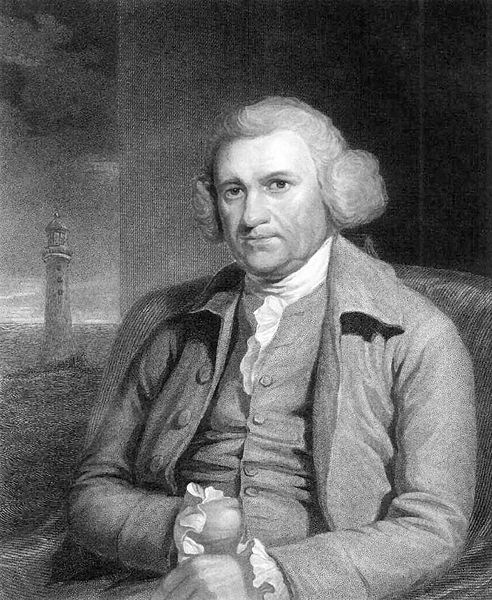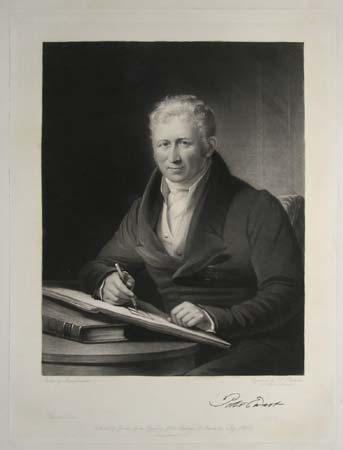<Back to Index>
- Engineer John Smeaton, 1724
- Engineer Peter Ewart, 1767
PAGE SPONSOR

John Smeaton, FRS, (8 June 1724 – 28 October 1792) was an English civil engineer responsible for the design of bridges, canals, harbors and lighthouses. He was also a capable mechanical engineer and an eminent physicist. Smeaton was the first self proclaimed civil engineer, and often regarded as the "father of civil engineering".
He was associated with the Lunar Society.
Smeaton was born in Austhorpe, Leeds, England. After studying at Leeds Grammar School he joined his father's law firm, but left to become a mathematical instrument maker (working with Henry Hindley), developing, among other instruments, a pyrometer to study material expansion and a whirling speculum or horizontal top (a maritime navigation aid).
He was elected a Fellow of the Royal Society in 1753, and in 1759 won the Copley Medal for his research into the mechanics of waterwheels and windmills. His 1759 paper "An Experimental Enquiry Concerning the Natural Powers of Water and Wind to Turn Mills and Other Machines Depending on Circular Motion" addressed the relationship between pressure and velocity for objects moving in air (Smeaton noted that the table doing so was actually contributed by "my friend Mr Rouse" "an ingenious gentleman of Harborough, Leicestershire" and calculated on the basis of Rouse's experiments), and his concepts were subsequently developed to devise the 'Smeaton Coefficient'.
Over the period 1759 - 1782 he performed a series of further experiments and measurements on waterwheels that led him to support and champion the vis viva theory of German Gottfried Leibniz, an early formulation of conservation of energy. This led him into conflict with members of the academic establishment who rejected Leibniz's theory, believing it inconsistent with Sir Isaac Newton's conservation of momentum.
Recommended by the Royal Society, Smeaton designed the third Eddystone Lighthouse (1755 – 59). He pioneered the use of 'hydraulic lime' (a form of mortar which will set under water) and developed a technique involving dovetailed blocks of granite in the building of the lighthouse. His lighthouse remained in use until 1877 when the rock underlying the structure's foundations had begun to erode; it was dismantled and partially rebuilt at Plymouth Hoe where it is known as Smeaton's Tower. He is important in the history, rediscovery of, and development of modern cement, because he identified the compositional requirements needed to obtain "hydraulicity" in lime; work which led ultimately to the invention of Portland cement.
Deciding that he wanted to focus on the lucrative field of civil engineering, he commenced an extensive series of commissions, including:
- the Calder and Hebble Navigation (1758 – 70);
- Coldstream Bridge over the River Tweed (1762 – 67);
- Improvements to the River Lee Navigation (1765 – 70);
- Perth Bridge over the River Tay in Perth (1766 – 71);
- Ripon Canal (1766 – 1773);
- Smeaton's Viaduct, which carries the A616 road (part of the original Great North Road) over the River Trent between Newark and South Muskham in Nottinghamshire (1768 – 70);
- the Forth and Clyde Canal from Grangemouth to Glasgow (1768 – 77);
- Banff harbor (1770 – 75);
- Aberdeen bridge (1775 – 80);
- Peterhead harbor (1775);
- Nent Force Level (1776 – 77);
- Harbor works at Ramsgate (retention basin 1776 - 83; jetty 1788 - 1792);
- Hexham bridge (1777 – 90);
- the Birmingham and Fazeley Canal (1782 – 89);
- St Austell's Charlestown harbor in Cornwall (1792).
Because of his expertise in engineering, Smeaton was called to testify in court for a case related to the silting up of the harbor at Wells - next - the - Sea in Norfolk in 1782: he is considered to be the first expert witness to appear in an English court. He also acted as a consultant on the disastrous 63 year long New Harbour at Rye, designed to combat the silting of the port of Winchelsea. The project is now known informally as "Smeaton's Harbour", but despite the name his involvement was limited and occurred more than 30 years after work on the harbor commenced.
Employing his skills as a mechanical engineer, he devised a water engine for the Royal Botanic Gardens at Kew in 1761 and a watermill at Alston, Cumbria, in 1767 (he is credited by some for inventing the cast iron axle shaft for waterwheels). In 1782 he built the Chimney Mill at Spital Tongues in Newcastle upon Tyne, the first 5 - sailed smock mill in Britain. He also improved Thomas Newcomen's atmospheric engine, erecting one at Chacewater mine, Wheal Busy, in Cornwall in 1775.
In 1789 Smeaton applied an idea by Denis Papin, by using a force pump to maintain the pressure and fresh air inside a diving bell. This bell, built for the Hexham bridge project, was not intended for underwater work, but in 1790 the design was updated to enable it to be used underwater on the breakwater at Ramsgate Harbour. Smeaton is also accredited for explaining the fundamental differences and benefits of Overshot Water wheels versus Undershot Water wheels.
Smeaton experimented with the Newcomen steam engine and made significant improvements around the time James Watt was building his first engines (ca. late 1770s).
Highly regarded by other engineers, he contributed to the Lunar Society and founded the Society of Civil Engineers in 1771. He coined the term civil engineers to distinguish them from military engineers graduating from the Royal Military Academy at Woolwich. After his death, the Society was renamed the Smeatonian Society, and was a forerunner of the Institution of Civil Engineers, established in 1818.
His pupils included canal engineer William Jessop and architect and engineer Benjamin Latrobe.
He died after suffering a stroke while walking in the garden of his family home at Austhorpe, and was buried in the parish church at Whitkirk, West Yorkshire.
John Smeaton Community College, a secondary school in the suburbs of Leeds adjacent to the Pendas Fields estate near Austhorpe, is named after Smeaton. He is also commemorated at the University of Plymouth, where the Mathematics and Technology Department is housed in a building named after him. A viaduct in the final stage of the Leeds Inner Ring Road, opened in 2008, was named after him.
He is mentioned in the song "I Predict a Riot" (as a symbol of a more dignified and peaceful epoch in Leeds history; and in reference to a Junior School House at Leeds Grammar School, which lead singer Ricky Wilson attended) by the indie rock band Kaiser Chiefs, who are natives of Leeds.
The lift equation used by the Wright brothers was due to John Smeaton. It has the form:
where:
 is the lift;
is the lift; is the Smeaton coefficient - 0.005 (the drag in pounds weight of a 1 square foot (0.093 m2) plate at 1 mph) was the value as determined by Smeaton, later corrected to 0.0033 by the Wright brothers;
is the Smeaton coefficient - 0.005 (the drag in pounds weight of a 1 square foot (0.093 m2) plate at 1 mph) was the value as determined by Smeaton, later corrected to 0.0033 by the Wright brothers; is the lift coefficient (the lift relative to the drag of a plate of the same area);
is the lift coefficient (the lift relative to the drag of a plate of the same area); is the area in square feet.
is the area in square feet.
The Wright brothers determined with wind tunnels that the Smeaton coefficient was incorrect and should have been 0.0033. In modern analysis, the Lift coefficient is normalized by the dynamic pressure instead of the Smeaton coefficient.

Peter Ewart (May 14, 1767 – September 15, 1842) was a British engineer who was influential in developing the technologies of turbines and theories of thermodynamics.
He was son of the Church of Scotland minister of Troqueer near Dumfries, and was one of eleven children. His brother Joseph Ewart became British ambassador to Prussia; John, a doctor, became Chief Inspector of East India Company hospitals in India; and William, father of William Ewart. was business partner of Sir John Gladstone, father of William Ewart Gladstone, whose godfather he was and whom he was named after.
After graduating from the University of Edinburgh, he was apprenticed to millwright John Rennie. His work with water wheels led him to work with Matthew Boulton and James Watt for whom by 1790 he was agent in Manchester. At the same time as acting as agent he was also trading on his own account as a millwright, enabling him to provide the complementary shafts, gears and other necessities to harness the power of the Boulton & Watt steam engines.
In 1792, frustrated in administering the immature and, as yet, unreliable machinery, he left Boulton and Watt to work in partnership with Samuel Oldknow in a cotton bleaching and calico printing venture. He anticipated this being a profitable concern but the partnership was dissolved within a year and he returned to engineering. In 1798 he went into partnership with Samuel Greg, installing an innovative water wheel at Greg's Quarry Bank Mill on the River Bollin in Cheshire. As a standby, he installed a Watt steam engine.
By 1811, Ewart had abandoned the venture with Greg to concentrate on his own manufacturing business but also his scientific work. He became, along with John Dalton, a vice president of the Manchester Literary and Philosophical Society and became active in the contemporary controversies about heat, work and energy. Motivated by a paper of John Playfair and encouraged by Dalton, in 1813 he published On the measure of moving force in which he defended the nascent ideas of the conservation of energy championed by John Smeaton. The paper was strongly to influence Dalton's pupil James Prescott Joule. A vocal advocate of the application of scientific knowledge in engineering, he was one of the founders of the Manchester Mechanics' Institute.
Ewart took up the post of Chief Engineer and Chief Inspector of Machinery with the Admiralty in 1835 and died on 15 September 1842 at Woolwich Dockyard when a chain snapped as he was supervising the removal of a boiler.